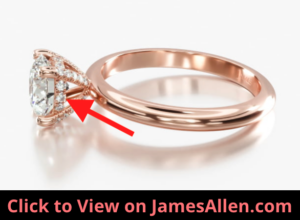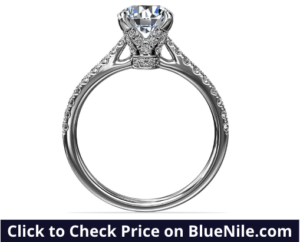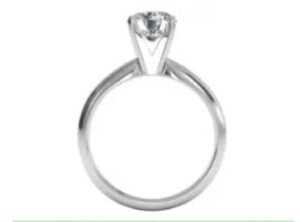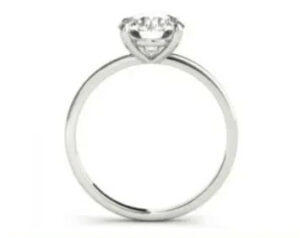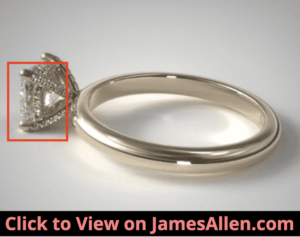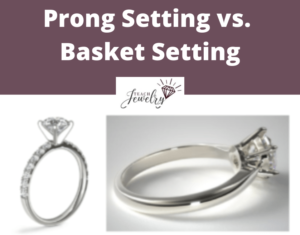
Prong and basket settings are two popular styles for holding the diamond in a piece of jewelry.
The main difference between a basket and prong setting is a basket setting has horizontal bands that connect each prong. This creates a basket where the diamond sits. Prong settings lack that bar connecting them, so the diamond’s pavilion is fully exposed.
Let’s explore basket settings versus prong settings, including an overview of each, five differences, and how to decide which is right for you.
What is a Prong Setting?
A prong setting often features four or six prongs that extend from its base to hold the diamond in place. The tips of the metal prongs are bent to grasp the edges of the gem.
Check out the prong setting below in 14K yellow gold.
Notice how at the top of the ring, the four prongs form a “V” shape on each side to secure the diamond.
It’s the most popular style of setting for engagement rings. One of its advantages is it showcases the most amount of the diamond compared to other settings.
This maximizes how much light enters and exits the stone, enhancing its brilliance.
A downside to prong settings is security. Thin prongs can wear down over time and let the diamond slip out. They can also get caught on hair and clothing, and if pulled too hard, can bend or break.
You may have to get them re-tipped every few years.
Prong settings are known for extensive variations. For example, Tiffany settings includes six prongs, but other variations include:
- Pointed prong tips
- Flat tab prongs
- V-prong
- Shared prong
Each is a subtle twist on the traditional setting that allows you to maintain the pros of a prong setting while adding your own style.
What is a Basket Setting?
A basket setting is a variation of a prong setting. The distinction is the horizontal bands that sit between each prong.
The vertical prongs and horizontal bands connect to form a basket where the diamond sits, so it’s surrounded on each side and held in place by its edges.
I’ve pointed out the basket in an image of the setting below.
I rotated the image 90 degrees, because the basket isn’t visible from the top-down or face-up view.
It’s an additional layer of security for the diamond because the entirety of its sides aren’t exposed. Instead, the basket covers about one-third of the diamond all the way around.
In other cases, the basket can cover even more of the diamond. This is caused by a thick metal bar or a smaller diamond.
Basket settings also come in multiple variations, including a cathedral setting with a basket. They can feature four or six prongs, joined all the way around by the metal shank.
To illustrate, here’s a basket setting with cathedral arches.
The two arches extend from the shank to form triangle gaps on both side. It doesn’t interfere with the way the diamond is held or secured.
For a more elegant setting, the sides of the basket can be engraved with floral designs.
This type covers up the pavilion of the diamond but offers a unique view when seen from the side.
How are Prong and Basket Settings Different?
1. Diamond Sit Higher in a Prong Setting
Prong settings place the ring higher off the band versus a basket setting.
You can’t identify this distinction when each setting is viewed from the top. But when you view it from the profile, you’ll notice this prominent feature of a basket setting, similar to trellis styles.
The advantage is it stands out from the setting and appears to have more brilliance.
Another reason buyers choose a high setting is because there’s more room for light to hit the diamond. It isn’t crowded by the shank, so it can collect the most light.
For example, check out how far this diamond sits from the ring.
The prongs are much longer than what you’ll find in most settings.
They also pair best with wedding rings. The diamond sits higher on your finger, so the wedding band can slide against it instead of interfering with the diamond.
The disadvantage is it’s more prone to damage. It more easily snags when it sits high, so I recommend you remove the ring during everyday chores and physical activity.
Basket settings, on the other hand, often sit much lower.
It offers added protection because the diamond is closer to your hand.
The downside is it lets in less light.
2. Prong Settings Improve Brilliance
A diamond’s brilliance can’t be on full display if it’s covered by the setting.
A prong setting minimizes the amount of diamond that’s covered, so the metal isn’t inhibiting the light.
This is in contrast to other types of setting such as bezel settings, which includes the band wrapping all the way around the diamond’s edges, and a basket setting.
The basket covers the lower part of the diamond’s pavilion.
To illustrate, examine this image of a basket setting.
The bar between the prongs covers the the middle third of the pavilion.
Its table and most of the pavilion is still exposed, so it can show brilliance.
It’s simply less when compared to the exposure offered by a prong setting.
3. Basket Settings Have More Room For Embellishment
Your choice of diamond isn’t the only consideration when it comes to building an engagement ring. There are many types of rings shanks and settings that alter the aesthetic of your jewelry.
Horizontal bands that form the basket offer an additional opportunity for embellishment. Some designs feature plain metal bands connecting the prongs, but others feature small diamonds lining the metal.
The engagement ring below is a four-prong basket setting with small diamonds on the prongs and basket.
These accents don’t add significant cost to the setting but do provide more brilliance. It makes up for the lost brilliance that results from covering part of the main diamond.
The most elegant designs can feature more than 20 accents all leading up the center stone. Even though it has many diamonds, the total carat weight of those accents is rarely more than half of a carat.
4. Basket Settings are More Secure
If the security of your diamond is a top priority, you should choose a basket versus prong setting. There are three reasons why the basket setting is more secure.
First, the diamond sits lower on the setting, so it isn’t as exposed to damage. It’s kept close to your hand.
The basket itself is another layer of security. Instead of being held in place by four or six prongs, it includes the metal wrapping around its base.
It won’t be as vulnerable to damage on its sides compared to a prong setting.
One exception is when there are diamonds lining the basket, like in this micro pavé setting.
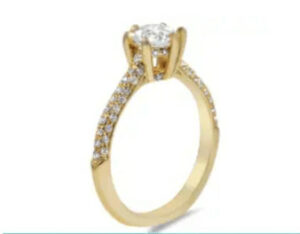
They aren’t in a vulnerable position, but they could dislodge. But they do put another barrier in front of the main diamond, which is most valuable.
In a prong setting, all sides of the diamond are exposed. This allows a knock against a hard surface or a drop to damage it on multiple sides.
Prongs are also stronger in a basket setting. The metal bands that form the basket add durability, so they’re less likely to bend or break over time.
5. Prong Settings are Easier to Clean
I recommend having your diamond and setting cleaned at least once a year, and this is easier to do when there’s no basket.
There are several pieces in a basket setting where dirt and debris accumulate, and these small areas are difficult to clean.
With more elegant designs that feature pave diamonds lining the basket, you’ll have to keep these diamonds free of grime as well.
A prong setting doesn’t have these more intricate areas, so cleaning doesn’t require as much effort. Accents don’t line the metal all the way around, so you don’t have as many diamonds to polish.
How to Decide Between Prong and Basket Settings
In deciding whether you should buy a basket or prong setting, you should determine which qualities are most important to you.
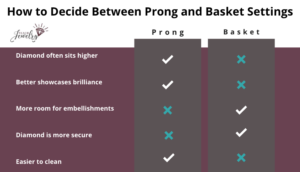
If the diamond’s brilliance is the priority, you should choose a prong setting because it showcases the maximum amount of the diamond. This allows light to enter and exit from all sides.
Additionally, if you have a large diamond, such as two or three carats, it’s best to have it sit higher off the setting, so prongs are the right choice.
If you’re most concerned about protecting your diamond from potential damage, a basket setting fits this criteria better than prongs. It secures the diamond on all sides and sits lower on the setting.
Once you understand the unique features of basket and prong settings, you can explore multiple options for each to learn which is right for you.

Jacob Clarke
Jacob Clarke is the founder of TeachJewelry.com.
He earned an Applied Jewelry Professional Diploma from the Gemological Institute of America (GIA) and now brings you essential information about diamonds, settings, and more.
Jacob has consulted with leading jewelry brands, and his work has been cited in Clean Origin, Diamond Nexus and industry publications.
He's also a member of the International Gem Society.
He enjoys discussing jewelry with readers, so contact him with any questions at jacob.clarke@teachjewelry.com.


